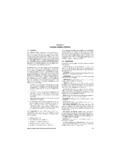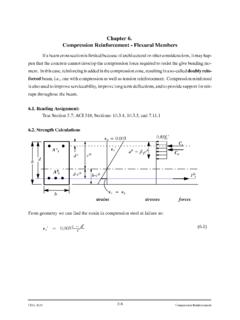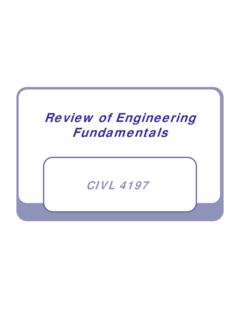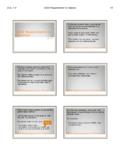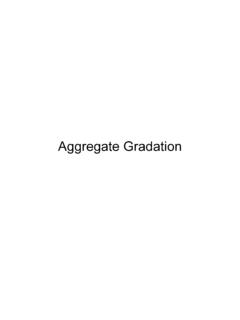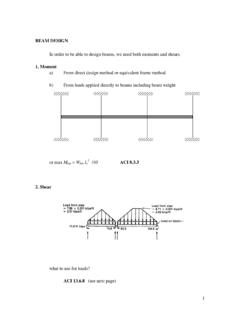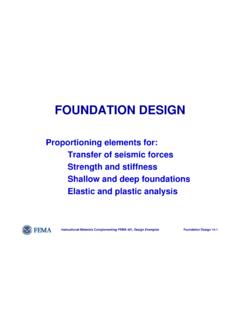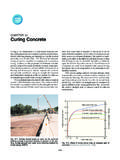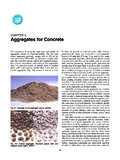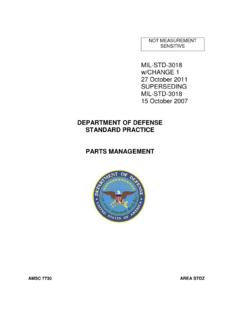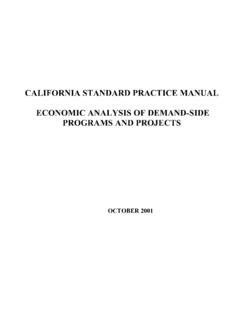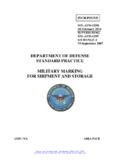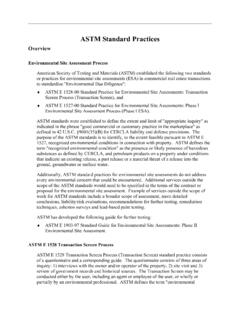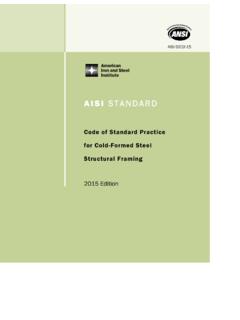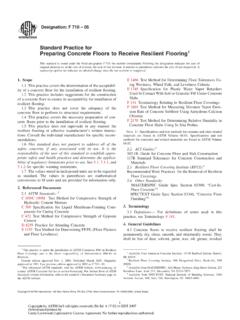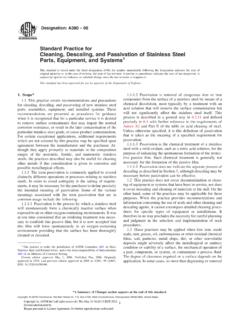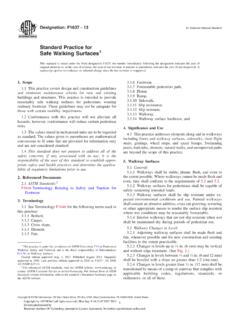Transcription of Standard Practice for Using Significant Digits in ...
1 Designation: D 6026 06 Standard Practice forUsing Significant Digits in geotechnical Data1 This Standard is issued under the fixed designation D 6026; the number immediately following the designation indicates the year oforiginal adoption or, in the case of revision, the year of last revision. A number in parentheses indicates the year of last reapproval. Asuperscript epsilon (e) indicates an editorial change since the last revision or Scope* This Practice is intended to promote uniformity inrecording significant Digits for measured and calculated valuesinvolving geotechnical data. The guidelines presented areindustry Standard , and are representative of the significantdigits that should generally be retained.
2 The guidelines do notconsider material variation, purpose for obtaining the data,special purpose studies, or any considerations for the user sobjectives; and it is common Practice to increase or reducesignificant Digits of reported data to be commensurate withthese considerations. It is beyond the scope of this Practice toconsider significant Digits used in analysis methods for engi-neering Using significant Digits in geotechnical data involvesthe processes of collecting, calculating, and recording eithermeasured values or calculated values (results), or This Practice accepts a variation of the traditionalrounding method that recognizes the algorithm common tomost hand-held calculators, The traditional roundingmethod ( ) is in accordance with PracticeE29 orIEEE/ASTM SI Practice offers a set of instructions for performingone or more specific operations.
3 This document cannot replaceeducation or experience and should be used in conjunctionwith professional judgment. Not all aspects of this Practice maybe applicable in all circumstances. This ASTM Standard is notintended to represent or replace the Standard of care by whichthe adequacy of a given professional service must be judged,nor should this document be applied without consideration ofa project s many unique aspects. The word Standard in thetitle of this document means only that the document has beenapproved through the ASTM consensus Referenced standards :2D 653 Terminology Relating to Soil, Rock, and ContainedFluidsD 2905 Practice for Statements on Number of Specimensfor TextilesD 4356 Practice for Establishing Consistent Test MethodTolerancesD 6913 Test Methods for Particle-Size Distribution (Grada-tion) of Soils Using Sieve AnalysisE29 Practice for Using Significant Digits in Test Data toDetermine Conformance with SpecificationsE 344 Terminology Relating to Thermometry and Hydrom-etryE 456 Terminology Relating to Quality and StatisticsE 833 Terminology of Building EconomicsIEEE/ASTM SI 10 Standard for Use of the InternationalSystem of Units (SI):The Modern Metric System3.
4 For common definitions of soil and rock terms in thisstandard, refer to TerminologyD ,n the degree of agreement of an individualmeasurement or average of measurements with an acceptedreference value, or level. See value,n the resulting value determinedby processing measured value(s) Using an equation. SeePracticeD 4356 - 84(Reapproved 1996). In many cases the calculated value(s)is considered a determination value(s). value,n the numerical quantity calcu-lated by means of the test method equation from the measure-ment values obtained as directed in a test method. See PracticeD 4356 - 84(Reapproved 1996). value,n the resulting value determinedby measuring a dimension, quantity, or In many cases the term measuredvalue(s) is also referred to as measurement value(s).
5 SeePracticeD 4356 - 84(Reapproved 1996). ,n the closeness of agreement betweenindependent test results obtained under stipulated TerminologyE 456 - Precision depends on random errorsand does not relate to the true or specified Practice is under the jurisdiction of ASTM Committee D18 on Soil andRock and is the direct responsibility of Subcommittee on StandardsDevelopment and edition approved Nov. 1, 2006. Published December 2006. Originallyapproved in 1996. Last previous edition approved in 2001 as D 6026 referenced ASTM standards , visit the ASTM website, , orcontact ASTM Customer Service at ForAnnual Book of ASTMS tandardsvolume information, refer to the Standard s Document Summary page onthe ASTM *A Summary of Changes section appears at the end of this ASTM International, 100 Barr Harbor Drive, PO Box C700, West Conshohocken, PA 19428-2959, United The measure of precision usually isexpressed in terms of imprecision and computed as a standarddeviation of the test results.
6 Less precision is reflected by alarger Standard Independent test results means re-sults obtained in a manner not influenced by any previousresult on the same or similar test object. Quantitative measuresof precision depend critically on the stipulated and reproducibility conditions are particular setsof extreme ,n the process of reducing the number ofdigits in a number according to rules relating to the requiredaccuracy of the digit any of the integers one through nineand zeros except leading zeros and some trailing Zero is a significant digit if it comes between twonon-zero Zeros leading the first nonzero digit of a numberindicate the order of magnitude only and are not significantdigits.
7 For example, the number has two Zeros trailing the last nonzero digit for numbersrepresented with a decimal point are significant Digits . Forexample, and have three significant The significance of trailing zeros for numbers rep-resented without use of a decimal point can only be identifiedfrom knowledge of the source of the result,n the value obtained by applying a giventest method, expressed as a single determination or a specifiedcombination of a number of determinations. See PracticeD 2905 - of Terms Specific to This analysis,n a test of the outcome of ananalysis by altering one or more parameters from an initiallyassumed value(s). See TerminologyE 833 - Sensitivity analyses are often related tothe design process, but not exactly applied in that designprocess.
8 A sensitivity analysis might include how measuredshear strength or hydraulic conductivity varies with moldingwater content and percent analysis,n the determination of the varia-tion in values within a given boundary condition(s) A variability analysis might includehow a given property varies with Significance and The guidelines presented in this Practice for retainingsignificant Digits and rounding numbers may be adopted by theusing agency or user. Generally, their adoption should be usedfor calculating and recording data when specified requirementsare not included in a The guidelines presented herein should not be inter-preted as absolute rules but as guides to calculate and reportobserved or test data without exaggerating or degrading theaccuracy of the The guidelines presented emphasize recording data toenough significant Digits or number of decimal places to allowsensitivity and variability analyses to be performed, Guidelines for Rounding Numbers in Calculating andRecording Discussion Rounding data avoids the mis-leading impression of precision while preventing the loss ofinformation due to coarse resolution.
9 Any approach to retentionof significant Digits of necessity involves some loss of infor-mation; therefore, the level of rounding should be selectedcarefully considering both planned and potential uses for thedata. See Numbers When a numerical value is to berounded to fewer Digits than the total number available, use thefollowing procedure which is in accordance with PracticeE29orIEEE/ASTM SI 10:When the first digitbeyond the last placeto be retained is:The digit in the lastplace retained is:Examples< to >5increased by to 5increased by to it is oddorunchanged if it is to followed onlysame as to zerosfor exactly to The rounded value should be obtained in one step bydirect rounding of the most precise value available and not intwo or more successive rounding steps.
10 For example, 89 490rounded to the nearest 1000 is at once 89 000. It would beincorrect to round first to the nearest 100, giving 89 500 andthen to the nearest 1000, giving 90 The same rule applies when rounding a number withmany Digits to a number with a few Digits as occurs when usinga computer or calculator that displays the answer to a compu-tation as ten or more Digits and the answer is to be recorded toa few Digits . For example, the number rounded to twosignificant Digits would be Calculators and computers, in general, do not followall the rules given , (that is, only rounding up odd digitsfollowed by a five, while even Digits stay the same ( to to )) and generally always round up.
